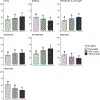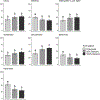Dose-response effects of two nicotine salt formulations on electronic cigarette appeal and sensory attributes
- PMID: 36593119
- PMCID: PMC10314953
- DOI: 10.1136/tc-2022-057553
Dose-response effects of two nicotine salt formulations on electronic cigarette appeal and sensory attributes
Abstract
Objectives: Various organic acids are used to create nicotine salt formulations, which may improve the appeal and sensory experience of vaping electronic cigarettes (e-cigarettes). This clinical experiment examined the effects of partially and highly protonated forms of two nicotine salt formulations (nicotine lactate and benzoate) versus free-base (no acid additive) on the appeal and sensory attributes of e-cigarettes.
Methods: Current adult tobacco product users (n=116) participated in an online remote double-blind within-subject randomised experiment involving standardised self-administration of e-cigarette solutions varying in nicotine formulation (free-base, 50% nicotine lactate -1:2 lactic acid to nicotine molar ratio, 100% nicotine lactate - 1:1 ratio, 50% nicotine benzoate and 100% nicotine benzoate). Each formulation had equivalent nicotine concentrations (27.0-33.0 mg/mL) and was administered in four flavours in a pod-style device. After each administration, participants rated appeal (liking, disliking and willingness to use again) and sensory attributes (0-100 scale).
Results: Compared with free-base nicotine, 50% and 100% nicotine lactate and benzoate yielded higher appeal, smoothness and sweetness and lower harshness and bitterness. Dose-response analyses found 100% vs 50% nicotine salt improved appeal, smoothness, bitterness and harshness for nicotine lactate and sweetness, smoothness and harshness for nicotine benzoate. Solutions with higher pH were associated with worse appeal and sensory attributes across nicotine formulations. Nicotine formulation effects did not differ by tobacco use status and flavours.
Conclusion: Restricting benzoic acid or lactic acid additives or setting minimal pHs in e-cigarettes merits consideration in regulations designed to reduce vaping among populations deterred from using e-cigarettes with aversive sensory properties.
Trial registration number: This study was registered under ClinicalTrials.gov Identifier: NCT03742817 under the title 'Effects of e-Cigarettes on Perceptions and Behavior'.
Keywords: electronic nicotine delivery devices; nicotine; non-cigarette tobacco products; public policy.
© Author(s) (or their employer(s)) 2023. No commercial re-use. See rights and permissions. Published by BMJ.
Conflict of interest statement
Competing interests: None declared.
Figures


Similar articles
-
Effect of Exposure to e-Cigarettes With Salt vs Free-Base Nicotine on the Appeal and Sensory Experience of Vaping: A Randomized Clinical Trial.JAMA Netw Open. 2021 Jan 4;4(1):e2032757. doi: 10.1001/jamanetworkopen.2020.32757. JAMA Netw Open. 2021. PMID: 33433597 Free PMC article. Clinical Trial.
-
Effects of 'Ice' flavoured e-cigarettes with synthetic cooling agent WS-23 or menthol on user-reported appeal and sensory attributes.Tob Control. 2025 Apr 1;34(2):175-182. doi: 10.1136/tc-2023-058125. Tob Control. 2025. PMID: 37940405 Free PMC article. Clinical Trial.
-
Sensory attributes of e-cigarette flavours and nicotine as mediators of interproduct differences in appeal among young adults.Tob Control. 2020 Nov;29(6):679-686. doi: 10.1136/tobaccocontrol-2019-055172. Epub 2019 Dec 18. Tob Control. 2020. PMID: 31852818 Free PMC article.
-
Impact of non-menthol flavours in e-cigarettes on perceptions and use: an updated systematic review.BMJ Open. 2019 Oct 16;9(10):e031598. doi: 10.1136/bmjopen-2019-031598. BMJ Open. 2019. PMID: 31619431 Free PMC article.
-
Impact of e-cigarette retail displays on attitudes to smoking and vaping in children: an online experimental study.Tob Control. 2023 Aug;32(e2):e220-e227. doi: 10.1136/tobaccocontrol-2021-056980. Epub 2022 Apr 13. Tob Control. 2023. PMID: 35418506 Free PMC article. Review.
Cited by
-
Pharmacokinetic differences in nicotine and nicotine salts mediate reinforcement-related behavior: an animal model study.Front Neurosci. 2023 Nov 16;17:1288102. doi: 10.3389/fnins.2023.1288102. eCollection 2023. Front Neurosci. 2023. PMID: 38033549 Free PMC article.
-
Quantification of Free Radicals from Vaping Electronic Cigarettes Containing Nicotine Salt Solutions with Different Organic Acid Types and Concentrations.Chem Res Toxicol. 2024 Jun 17;37(6):991-999. doi: 10.1021/acs.chemrestox.4c00065. Epub 2024 May 22. Chem Res Toxicol. 2024. PMID: 38778043 Free PMC article.
-
Nicotine Formulation Influences the Autonomic and Arrhythmogenic Effects of Electronic Cigarettes.Nicotine Tob Res. 2024 Apr 22;26(5):536-544. doi: 10.1093/ntr/ntad237. Nicotine Tob Res. 2024. PMID: 38011908 Free PMC article.
-
Effect of packaging with versus without candy-oriented marketing themes on the appeal and sensory attributes of flavoured e-cigarettes.Tob Control. 2024 Oct 9:tc-2024-058904. doi: 10.1136/tc-2024-058904. Online ahead of print. Tob Control. 2024. PMID: 39384403
-
E-Cigarette Nicotine Delivery Among Young Adults by Nicotine Form, Concentration, and Flavor: A Crossover Randomized Clinical Trial.JAMA Netw Open. 2024 Aug 1;7(8):e2426702. doi: 10.1001/jamanetworkopen.2024.26702. JAMA Netw Open. 2024. PMID: 39120901 Free PMC article. Clinical Trial.
References
-
- Pennings JL, Havermans A, Pauwels CG, Krüsemann EJ, Visser WF. Talhout R. Comprehensive Dutch market data analysis shows that e-liquids with nicotine salts have both higher nicotine and flavour concentrations than those with free-base nicotine. Tob Control. Published Online First: 5 January 2022. doi: 10.1136/tobaccocontrol-2021-056952. - DOI - PMC - PubMed
Associated data
Grants and funding
LinkOut - more resources
Full Text Sources
Medical
